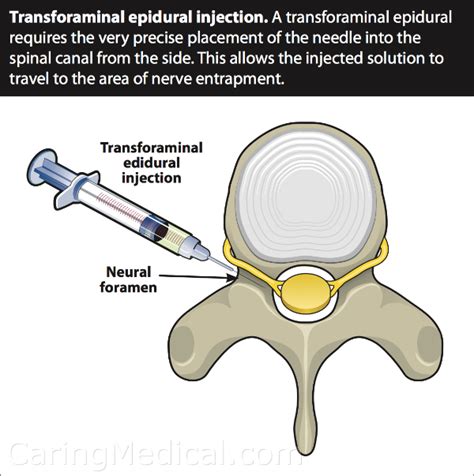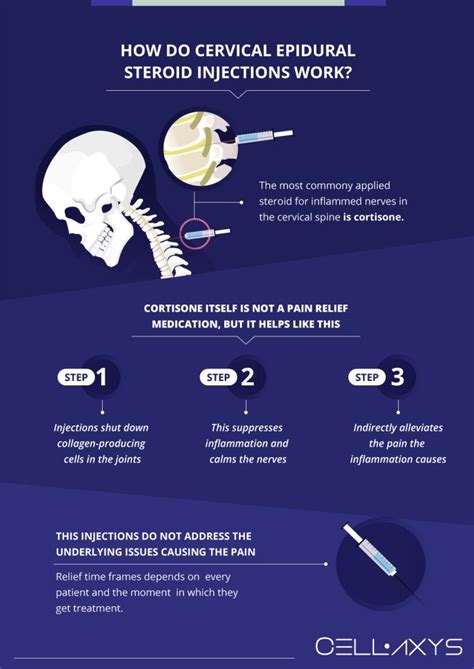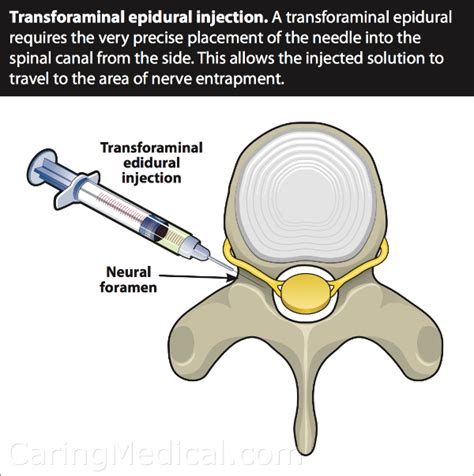Intro
Find relief from neck and back pain with Cervical Epidural Steroid Injection, a minimally invasive procedure providing spinal pain management, epidural steroid relief, and chronic pain treatment, reducing inflammation and discomfort.
Cervical epidural steroid injections have become a popular treatment option for individuals suffering from neck and arm pain caused by inflamed spinal nerves. This minimally invasive procedure involves injecting a corticosteroid into the epidural space surrounding the spinal cord to reduce inflammation and alleviate pain. The goal of this treatment is to provide relief from chronic pain, allowing patients to regain mobility and improve their overall quality of life. As the demand for effective pain management solutions continues to grow, it's essential to understand the benefits, working mechanisms, and potential risks associated with cervical epidural steroid injections.
The importance of addressing chronic pain cannot be overstated, as it affects millions of people worldwide, impacting their daily activities, relationships, and mental health. Traditional pain management methods often involve medication, physical therapy, or surgery, but these approaches may not always provide adequate relief. Cervical epidural steroid injections offer a valuable alternative, as they can target the source of the pain directly, reducing inflammation and discomfort. By exploring the intricacies of this treatment, patients can make informed decisions about their care and potentially find the relief they've been seeking.
As medical technology advances, the development of minimally invasive procedures like cervical epidural steroid injections has revolutionized the field of pain management. These injections are typically performed on an outpatient basis, using local anesthesia and imaging guidance to ensure precision and safety. The procedure involves inserting a small needle into the epidural space, where the corticosteroid is administered to reduce inflammation and relieve pressure on the affected nerves. By understanding the working mechanisms and benefits of cervical epidural steroid injections, patients can better navigate their treatment options and work towards achieving lasting pain relief.
Cervical Epidural Steroid Injection Procedure

Preparation and Aftercare
To ensure a smooth and successful procedure, patients are advised to follow specific preparation and aftercare instructions. This may include avoiding certain medications, such as blood thinners, and refraining from eating or drinking for a specified period before the procedure. After the injection, patients may experience some soreness or discomfort at the injection site, which can be managed with over-the-counter pain medication. It's essential to follow the physician's instructions carefully to minimize potential risks and optimize the effectiveness of the treatment.Benefits of Cervical Epidural Steroid Injections

Risks and Complications
While cervical epidural steroid injections are generally considered safe, there are potential risks and complications to be aware of. These may include: * Infection or bleeding at the injection site * Nerve damage or irritation * Allergic reactions to the corticosteroid or other medications used during the procedure * Temporary increase in pain or discomfort It's essential to discuss these potential risks with a healthcare professional to determine the best course of treatment and ensure that the benefits of the procedure outweigh the risks.Cervical Epidural Steroid Injection Effectiveness

Combination Therapies
In some cases, cervical epidural steroid injections may be used in combination with other therapies, such as physical therapy, medication, or alternative treatments like acupuncture or chiropractic care. This multidisciplinary approach can help to enhance the effectiveness of the treatment, providing patients with a comprehensive pain management plan. By working with a healthcare professional to develop a personalized treatment plan, patients can optimize their chances of achieving lasting pain relief.Cervical Epidural Steroid Injection Alternatives

Future Developments
As medical technology continues to advance, new developments and innovations in the field of pain management are emerging. These may include the use of novel corticosteroids or other medications, as well as the development of more advanced imaging guidance systems. By staying informed about the latest advancements and research, patients can make informed decisions about their care and potentially benefit from cutting-edge treatments.Cervical Epidural Steroid Injection Cost

Insurance Coverage
Insurance coverage for cervical epidural steroid injections can vary depending on the patient's policy and the specific circumstances of their treatment. In some cases, insurance may cover a portion or all of the costs associated with the procedure. It's essential to verify insurance coverage and any out-of-pocket expenses before undergoing treatment to avoid unexpected financial burdens.What are the potential risks and complications of cervical epidural steroid injections?
+Potential risks and complications include infection, bleeding, nerve damage, and allergic reactions to the corticosteroid or other medications used during the procedure.
How long does it take to recover from a cervical epidural steroid injection?
+Most patients can resume normal activities within a day or two after the procedure, although some may experience temporary soreness or discomfort at the injection site.
Can cervical epidural steroid injections be used in combination with other therapies?
+Yes, cervical epidural steroid injections can be used in combination with other therapies, such as physical therapy, medication, or alternative treatments like acupuncture or chiropractic care, to enhance the effectiveness of the treatment.
How many cervical epidural steroid injections are typically needed to achieve optimal results?
+The number of injections needed can vary depending on individual circumstances, such as the severity and duration of the pain, and the patient's response to the treatment.
Are cervical epidural steroid injections suitable for everyone?
+No, cervical epidural steroid injections may not be suitable for everyone, particularly those with certain medical conditions, such as bleeding disorders or infections, or those who are taking certain medications.
In conclusion, cervical epidural steroid injections offer a valuable treatment option for individuals suffering from chronic neck and arm pain. By understanding the benefits, working mechanisms, and potential risks associated with this procedure, patients can make informed decisions about their care and potentially find the relief they've been seeking. If you're considering cervical epidural steroid injections, we encourage you to discuss your options with a healthcare professional and explore the various resources available to help you navigate your treatment journey. Share your thoughts and experiences with others, and don't hesitate to reach out to a medical professional if you have any questions or concerns about this or other pain management treatments.
